Abstract
Purpose
A primary enabling feature of near-infrared fluorescent proteins (FPs) and fluorescent probes is the ability to visualize deeper in tissues than in the visible. The purpose of this work is to find which is the optimal visualization method that can exploit the advantages of this novel class of FPs in full-scale pre-clinical molecular imaging studies.
Procedures
Nude mice were stereotactically implanted with near-infrared FP expressing glioma cells to from brain tumors. The feasibility and performance metrics of FPs were compared between planar epi-illumination and trans-illumination fluorescence imaging, as well as to hybrid Fluorescence Molecular Tomography (FMT) system combined with X-ray CT and Multispectral Optoacoustic (or Photoacoustic) Tomography (MSOT).
Results
It is shown that deep-seated glioma brain tumors are possible to visualize both with fluorescence and optoacoustic imaging. Fluorescence imaging is straightforward and has good sensitivity; however, it lacks resolution. FMT-XCT can provide an improved rough resolution of ∼1 mm in deep tissue, while MSOT achieves 0.1 mm resolution in deep tissue and has comparable sensitivity.
Conclusions
We show imaging capacity that can shift the visualization paradigm in biological discovery. The results are relevant not only to reporter gene imaging, but stand as cross-platform comparison for all methods imaging near infrared fluorescent contrast agents.






Similar content being viewed by others
References
Shaner NC, Campbell RE, Steinbach PA et al (2004) Improved monomeric red, orange and yellow fluorescent proteins derived from Discosoma sp red fluorescent protein. Nat Biotechnol 22:1567–1572
Lin MZ, McKeown MR, Ng HL et al (2009) Autofluorescent proteins with excitation in the optical window for intravital imaging in mammals. Chem Biol 16:1169–1179
Strack RL, Hein B, Bhattacharyya D et al (2009) A Rapidly Maturing Far-Red Derivative of DsRed-Expres2 for Whole-Cell Labeling. Biochemistry 48:8279–8281
Morozova KS, Piatkevich KD, Gould TJ et al (2010) Far-Red Fluorescent Protein Excitable with Red Lasers for Flow Cytometry and Superresolution STED Nanoscopy. Biophys J 99:L13–L15
Shcherbo D, Shemiakina II, Ryabova AV et al (2010) Near-infrared fluorescent proteins. Nat Methods 7:827–U1520
Shcherbo D, Murphy CS, Ermakova GV et al (2009) Far-red fluorescent tags for protein imaging in living tissues. Biochem J 418:567–574
Willig KI, Kellner RR, Medda R et al (2006) Nanoscale resolution in GFP-based microscopy. Nat Methods 3:721–723
Wallrabe H, Periasamy A (2005) Imaging protein molecules using FRET and FLIM microscopy. Curr Opin Biotechnol 16:19–27
Jares-Erijman EA, Jovin TM (2003) FRET imaging. Nat Biotechnol 21:1387–1395
Shu X, Royant A, Lin MZ et al (2009) Mammalian Expression of Infrared Fluorescent Proteins Engineered from a Bacterial Phytochrome. Science 324:804–807
Filonov GS, Piatkevich KD, Ting LM et al (2011) Bright and stable near-infrared fluorescent protein for in vivo imaging. Nat Biotechnol 29:757–761
Shcherbakova DM, Verkhusha VV (2013) Near-infrared fluorescent proteins for multicolor in vivo imaging. Nat Methods.
Ntziachristos V (2010) Going deeper than microscopy: the optical imaging frontier in biology. Nat Methods 7:603–614
Stritzker J, Kirscher L, Scadeng M et al (2013) Vaccinia virus-mediated melanin production allows MR and optoacoustic deep tissue imaging and laser-induced thermotherapy of cancer. Proc Natl Acad Sci USA 110:3316–3320
Yang M, Baranov E, Jiang P et al (2000) Whole-body optical imaging of green fluorescent protein-expressing tumors and metastases. Proc Natl Acad Sci USA 97:1206–1211
Contag CH, Bachmann MH (2002) Advances in vivo bioluminescence imaging of gene expression. Annu Rev Biomed Eng 4:235–260
Graves EE, Ripoll J, Weissleder R, Ntziachristos V (2003) A submillimeter resolution fluorescence molecular imaging system for small animal imaging. Med Phys 30:901–911
Deliolanis NC, Lasser T, Hyde D et al (2007) Free-space fluorescence molecular tomography utilizing 360° geometry projections. Opt Lett 32:382–384
Wang XD, Pang YJ, Ku G et al (2003) Noninvasive laser-induced photoacoustic tomography for structural and functional in vivo imaging of the brain. Nat Biotechnol 21:803–806
Razansky D, Vinegoni C, Ntziachristos V (2007) Multispectral photoacoustic imaging of fluorochromes in small animals. Opt Lett 32:2891–2893
Brecht HP, Su R, Fronheiser M et al (2009) Whole-body three-dimensional optoacoustic tomography system for small animals. J Biomed Opt 14:064007
Burton NC, Patel M, Morscher S et al (2012) Multispectral opto-acoustic tomography (MSOT) brain imaging and characterization of glioblastoma. Neuroimage 65:522–528
Razansky D, Distel M, Vinegoni C et al (2009) Multispectral opto-acoustic tomography of deep-seated fluorescent proteins in vivo. Nat Photonics 3:412–417
Filonov GS, Krumholz A, Xia J et al (2012) Deep-tissue photoacoustic tomography of a genetically encoded near-infrared fluorescent probe. Angew Chem Int Ed Engl 51:1448–1451
Hyde D, Miller E, Brooks DH, Ntziachristos V (2007) A statistical approach to inverting the Born ratio. IEEE Trans Med Imag 26:893–905
Schulz RB, Ale A, Sarantopoulos A et al (2010) Hybrid system for simultaneous fluorescence and x-ray computed tomography. IEEE Trans Med Imaging 29:465–473
Ale A, Ermolayev V, Herzog E et al (2012) FMT-XCT: in vivo animal studies with hybrid fluorescence molecular tomography-X-ray computed tomography. Nat Methods 9:615–620
Rockley MG, Waugh KM (1978) The photoacoustic determination of fluorescence yields of dye solutions. Chem Phys Lett 54:597–599
Tomasini EP, San Roman E, Braslavsky SE (2009) Validation of Fluorescence Quantum Yields for Light-Scattering Powdered Samples by Laser-Induced Optoacoustic Spectroscopy. Langmuir 25:5861–5868
Kurian E, Prendergast FG, Small JR (1997) Photoacoustic analysis of proteins: volumetric signals and fluorescence quantum yields. Biophys J 73:466–476
Deliolanis NC, Kasmieh R, Wurdinger T et al (2008) Performance of the red-shifted fluorescent proteins in deep-tissue molecular imaging applications. J Biomed Opt 13:044008
Deliolanis NC, Wurdinger T, Pike L et al (2011) In vivo tomographic imaging of red-shifted fluorescent proteins. Biomed Opt Express 2:887–900
Cheong WF, Prahl SA, Welch AJ (1990) A review of the optical properties of biological tissues. IEEE J Quantum Electron 26:2166–2185
Glatz J, Deliolanis NC, Buehler A et al (2011) Blind source unmixing in multi-spectral optoacoustic tomography. Opt Express 19:3175–3184
Tzoumas S, Deliolanis N, Morscher S, Ntziachristos V (2013) Un-mixing Molecular Agents from Absorbing Tissue in Multispectral Optoacoustic Tomography. IEEE Trans Med Imaging.
Buehler A, Herzog E, Razansky D, Ntziachristos V (2010) Video rate optoacoustic tomography of mouse kidney perfusion. Opt Lett 35:2475–2477
Rosenthal A, Razansky D, Ntziachristos V (2010) Fast semi-analytical model-based acoustic inversion for quantitative optoacoustic tomography. IEEE Trans Med Imaging 29:1275–1285
Hyvarinen A (1999) Fast and robust fixed-point algorithms for independent component analysis. IEEE Trans Neural Netw 10:626–634
Acknowledgments
The authors would like to acknowledge the help of Irene Ho and Uwe Klemm in the cell culture, Dr. Nicolas Bézière in MSOT imaging, and Dr. Vladislav Verkhusha for providing the U87-iRFP cells and the FP extracts. V.N. acknowledges support from the European Research Council (ERC) Advanced Researcher Grant. D.R. acknowledges support from the German Research Foundation (DFG) Research Grant (RA 1848/1) and the European Research Council (ERC) Starting Independent Researcher Grant.
Author Contributions
V.N., D.R., and N.C.D. conceived the research, N.C.D., A.A., K.R., N.C.B., K.S., and S.M. designed the experiments, K.S. did the cell culture, N.C.B and N.C.D. carried out the brain implantations, and N.C.D., A.A., K.R., and S.M. carried out the imaging experiments and performed data analysis. All authors contributed in writing the manuscript.
Conflict of Interest
V.N. and D.R. have financial interest with iThera Medical GmbH, while N.C.B. and S.M. are employees of iThera Medical GmbH.
Author information
Authors and Affiliations
Corresponding author
Electronic Supplementary Material
Below is the link to the electronic supplementary material.
ESM 1
(PDF 160 kb)
Rights and permissions
About this article
Cite this article
Deliolanis, N.C., Ale, A., Morscher, S. et al. Deep-Tissue Reporter-Gene Imaging with Fluorescence and Optoacoustic Tomography: A Performance Overview. Mol Imaging Biol 16, 652–660 (2014). https://doi.org/10.1007/s11307-014-0728-1
Published:
Issue Date:
DOI: https://doi.org/10.1007/s11307-014-0728-1




